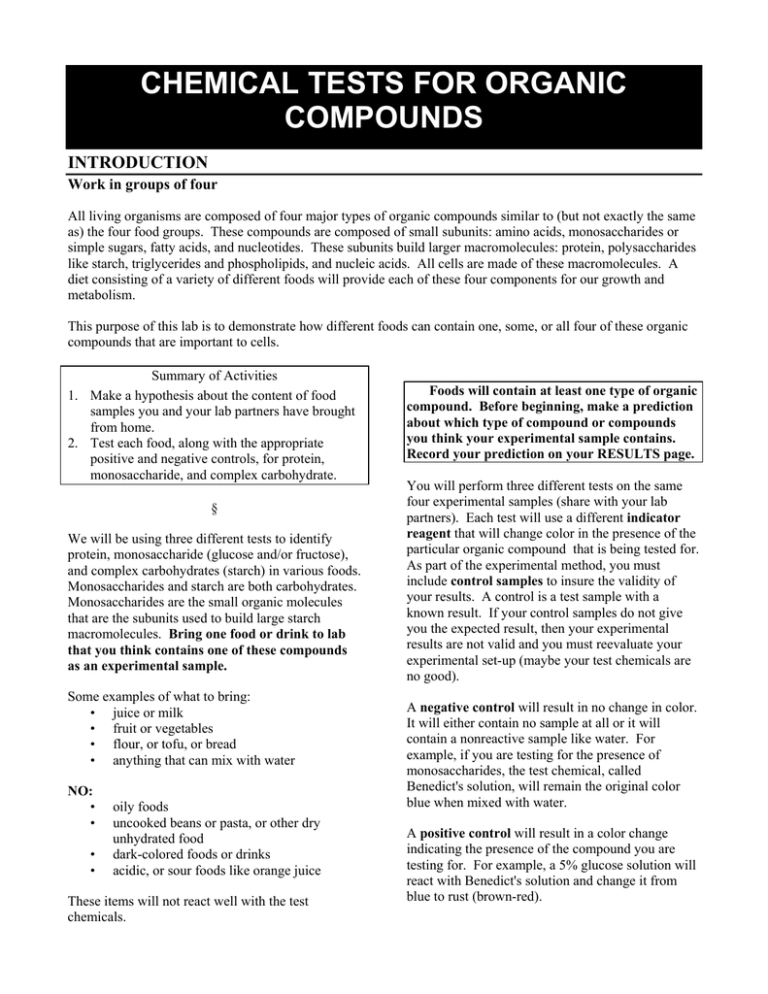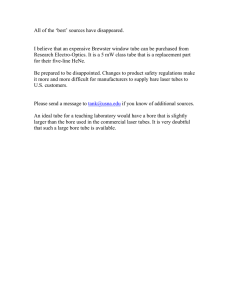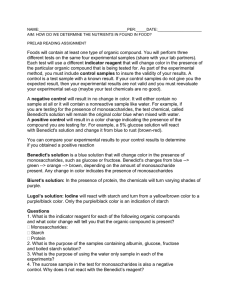CHEMICAL TESTS FOR ORGANIC COMPOUNDS INTRODUCTION Work in groups of four
advertisement

CHEMICAL TESTS FOR ORGANIC COMPOUNDS INTRODUCTION Work in groups of four All living organisms are composed of four major types of organic compounds similar to (but not exactly the same as) the four food groups. These compounds are composed of small subunits: amino acids, monosaccharides or simple sugars, fatty acids, and nucleotides. These subunits build larger macromolecules: protein, polysaccharides like starch, triglycerides and phospholipids, and nucleic acids. All cells are made of these macromolecules. A diet consisting of a variety of different foods will provide each of these four components for our growth and metabolism. This purpose of this lab is to demonstrate how different foods can contain one, some, or all four of these organic compounds that are important to cells. Summary of Activities 1. Make a hypothesis about the content of food samples you and your lab partners have brought from home. 2. Test each food, along with the appropriate positive and negative controls, for protein, monosaccharide, and complex carbohydrate. § We will be using three different tests to identify protein, monosaccharide (glucose and/or fructose), and complex carbohydrates (starch) in various foods. Monosaccharides and starch are both carbohydrates. Monosaccharides are the small organic molecules that are the subunits used to build large starch macromolecules. Bring one food or drink to lab that you think contains one of these compounds as an experimental sample. Some examples of what to bring: • juice or milk • fruit or vegetables • flour, or tofu, or bread • anything that can mix with water NO: • • • • oily foods uncooked beans or pasta, or other dry unhydrated food dark-colored foods or drinks acidic, or sour foods like orange juice These items will not react well with the test chemicals. Foods will contain at least one type of organic compound. Before beginning, make a prediction about which type of compound or compounds you think your experimental sample contains. Record your prediction on your RESULTS page. You will perform three different tests on the same four experimental samples (share with your lab partners). Each test will use a different indicator reagent that will change color in the presence of the particular organic compound that is being tested for. As part of the experimental method, you must include control samples to insure the validity of your results. A control is a test sample with a known result. If your control samples do not give you the expected result, then your experimental results are not valid and you must reevaluate your experimental set-up (maybe your test chemicals are no good). A negative control will result in no change in color. It will either contain no sample at all or it will contain a nonreactive sample like water. For example, if you are testing for the presence of monosaccharides, the test chemical, called Benedict's solution, will remain the original color blue when mixed with water. A positive control will result in a color change indicating the presence of the compound you are testing for. For example, a 5% glucose solution will react with Benedict's solution and change it from blue to rust (brown-red). You can compare your experimental results to your control results to determine if you obtained a positive reaction. 2. Label your tubes 1 through 6. 3. Prepare your sample following the instructions from above. To Prepare Your Samples: 1. If your experimental sample is solid, chop or break it up into the smallest pieces possible using a razor blade or glass rod, whichever is appropriate. Use a pinch of sample small enough so that the material can be easily suspended in 1.5 ml of water and does not fill the bottom of the tube. • Add 1.5 ml distilled water to your sample and mix it well. 4. CAUTIOUSLY add 20 drops of 10% NaOH solution to each tube. Agitate the tube gently. See instructor for demonstration. 5. Add 4 drops of 0.5% CuSO4 to each tube. Agitate the tubes again. 6. Let the tubes sit at room temperature a few minutes, until you see a color change in your positive control. 7. Record the results. 2. If your sample is a liquid, add 1.5 ml of the liquid to the appropriate tube. 3. Each tube should have the same volume of fluid, regardless of the type of sample. I. Identification of Protein Materials: • test tube rack • test tubes • tape for labeling your tubes • 0.5% CuSO4 • 10% NaOH • albumin protein solution (egg white) • distilled water • four different experimental samples (share with the people at your table) The test chemicals used in this experiment react with the covalent bonds that link amino acids together in protein chains. In the presence of protein, the chemicals will turn varying shades of purple. II. Identification of Monosaccharides Materials: • hot plate • 400 ml beaker half filled with boiling water • test tube clamp for picking hot test tubes • Benedict's solution • 5% glucose solution • 5% fructose solution • 5% sucrose solution • distilled water • 4 experimental samples Benedict's solution is a blue solution that will change color in the presence of monosaccharides, such as glucose or fructose. Benedict's changes from blue --> green --> orange --> brown, depending on the amount of monosaccharide present. Any change in color indicates the presence of monosaccharides. Procedure: NOTE: NaOH (sodium hydroxide) is very caustic and will burn your skin and damage your clothes. Handle it with caution. If you do come into contact with it, notify the instructor and flush the area thoroughly with running water. NaOH is the ingredient in hair removal products like Nair. It works by dissolving protein, which is what hair is made of. 1. Set up a boiling water bath using a 400 ml beaker filled with approximately 150 ml of tap water on a hot plate. Add 2 or 3 boiling chips to the water in the beaker. These will prevent boiling water from slashing up when you add your test tubes. Set the hot plate on high to get the water boiling, then reduce the temperature to a setting of "2" to keep the water simmering. The water should be boiling BEFORE you place your tubes in it. Procedure: 2. Label your tubes 1 through 8. 1. Predict which organic compounds your experimental samples might contain. If you are using tape, make sure the tape is high enough on the tube so that it does not get wet in the water bath. Otherwise, the tape will fall off and you will not be able to identify your samples. 3. Prepare your samples as before. 4. Add 1.5 ml of Benedict's solution to each test tube, for a total of 3 ml. 5. Agitate your tubes so that the sample and Benedict's is well mixed. See instructor for demonstration. 6. Place the all the test tubes at the same time in the boiling water bath for 5 minutes. 7. Remove the tubes using the test tube clamp and record the resulting color. Do not mix the tubes again once they have been boiled. If your sample was a solid, note the color change in the immediate vicinity of your sample. The rest of the Benedict's may stay blue since a solid cannot mix well. III. Identification of Starch (Complex Carbohydrate) Materials: • Iodine solution (IKI) • Starch suspension • distilled water • 4 experimental samples Iodine will react with starch and turn from a yellow/brown color to a purple/black color. Only the purple/black color is an indication of starch. Procedure: 1. Number your tubes. 2. Prepare your samples as before. Remember, each tube should have 1.5 ml of liquid. 3. Add 2-3 drops IKI to each tube. Agitate your tubes. 4. Record your results. Data Sheets: Turn in with lab report Before you begin, predict which organic compounds may be found in each of your samples. Experimental Samples Color of Sample Predicted Organic Compound(s) #1: #2: #3: #4: I. Identification of Protein Tube # Solution in tube: II. 1 1.5 ml albumin solution 2 1.5 ml distilled water 3 Sample #1: 4 Sample #2: 5 Sample #3: 6 Sample #4: Color of reaction Presence of Protein? (yes or no) Identification of Monosaccharides Tube # Solution in tube: 1 1.5 ml 5% glucose solution 2 1.5 ml 5% fructose solution 3 1.5 ml 5% sucrose solution 4 1.5 ml distilled water 5 Sample #1: 6 Sample #2: 7 Sample #3: 8 Sample #4: Color of Reaction Before After Heating Heating 4 Presence of monosaccharides? III. Identification of Starch Tube # Solution in tube: 1 1.5 ml boiled starch 2 1.5 ml distilled water 3 Sample #1: 4 Sample #2: 5 Sample #3: 6 Sample #4: Color of Reaction Presence of Starch? QUESTIONS FOR YOUR REPORT 1. Present an abstract of your work. Your abstract should include a brief description (1/2 page) of 1) what you set out to learn, 2) what procedures you performed, and 3) a summary of your data or discoveries. 2. Turn in your Data Sheets 3. What is the purpose of samples containing albumin, glucose, fructose, and boiled starch solution? What is the purpose of using the water only sample in each of the experiments? 4. Why does sucrose not react with the Benedict's reagent? 5. Draw the chemical structures of a monosaccharide and amino acid of your choice. Be sure to label the name of the specific molecules you choose. 6. Draw out a dehydration synthesis reaction using your monosaccharide from question #5. Draw the structure of your new compound. 7. For each food you tested, list the organic compounds it contained. How do your results compare to your original predictions? Explain. 8. Based on what you learned from today’s experiment, explain why it is important to eat a variety of foods. 9. (2 pts) Imagine you have discovered a new drug to treat a human disease. You want to test it in a clinical trial to see that it is effective (or maybe even more effective than existing drugs). Design an experiment for your clinical trial. Describe your design and indicate what your negative and positive controls are. What might be some of the difficulties of applying good scientific method to humans? 5




